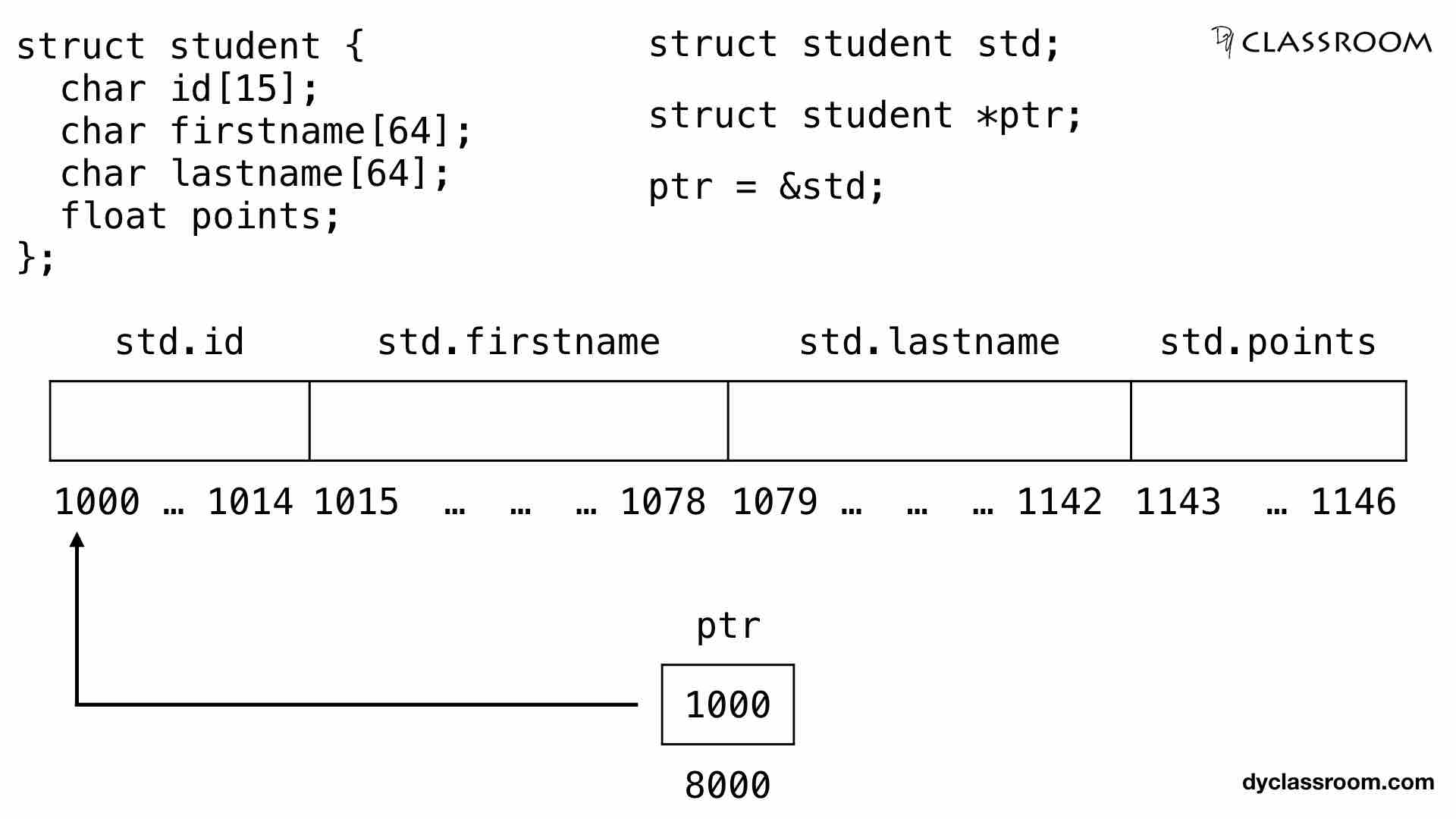
C - Pointers and Structures
C Programming
In this tutorial we will learn to use pointers with structures in C programming language.
We have learned how to create and work with structures in the Structures tutorial. Feel free to check that out.
Creating a structure
Lets start by creating a structure variable student as shown below.
// student structure
struct student {
char id[15];
char firstname[64];
char lastname[64];
float points;
};
Now we will create a student structure variable std. For this we will write the following code.
// student structure variable
struct student std;
Access the members of a structure
We know that to access a member of a structure we use the . operator.
In the following example we are accessing the members of the student structure.
printf("ID: %s\n", std.id);
printf("First Name: %s\n", std.firstname);
printf("Last Name: %s\n", std.lastname);
printf("Points: %f\n", std.points);
Creating pointer for structure
Following is the syntax to create a pointer for a structure.
struct tagName *ptrName;
So, to create a pointer for the student structure we will write the following code.
struct student *ptr;
Assigning structure variable to pointer
We use the following syntax to assign a structure variable address to a pointer.
ptrName = &structVarName;
In the following example we are assigning the address of the structure variable std to the structure pointer variable ptr. So, ptr is pointing at std.
ptr = &std;
Accessing the members of a structure via pointer
We use the arrow operator also known as member selection operator -> to access the members of a structure via pointer variable.
Following is the syntax for accessing members of a structure via pointer.
ptrName->member
In the following example we are accessing the firstname member of the student structure via pointer variable ptr.
printf("First Name: %s", ptr->firstname);
Complete code
#include <stdio.h>
int main(void) {
// student structure
struct student {
char id[15];
char firstname[64];
char lastname[64];
float points;
};
// student structure variable
struct student std;
// student structure pointer variable
struct student *ptr = NULL;
// assign std to ptr
ptr = &std;
// get student detail from user
printf("Enter ID: ");
scanf("%s", ptr->id);
printf("Enter first name: ");
scanf("%s", ptr->firstname);
printf("Enter last name: ");
scanf("%s", ptr->lastname);
printf("Enter Points: ");
scanf("%f", &ptr->points);
// display result via std variable
printf("\nResult via std\n");
printf("ID: %s\n", std.id);
printf("First Name: %s\n", std.firstname);
printf("Last Name: %s\n", std.lastname);
printf("Points: %f\n", std.points);
// display result via ptr variable
printf("\nResult via ptr\n");
printf("ID: %s\n", ptr->id);
printf("First Name: %s\n", ptr->firstname);
printf("Last Name: %s\n", ptr->lastname);
printf("Points: %f\n", ptr->points);
return 0;
}
Output:
Enter ID: s01
Enter first name: Yusuf
Enter last name: Shakeel
Enter Points: 8.44
Result via std
ID: s01
First Name: Yusuf
Last Name: Shakeel
Points: 8.440000
Result via ptr
ID: s01
First Name: Yusuf
Last Name: Shakeel
Points: 8.440000
We can represent the student structure variable std in memory as follows.

So, when we create the structure variable std it takes up 147 bytes of memory space.
| Member | Data Type | Size | Memory Location |
|---|---|---|---|
| id | char | 15 bytes | 1000 to 1014 |
| firstname | char | 64 bytes | 1015 to 1078 |
| lastname | char | 64 bytes | 1079 to 1142 |
| points | float | 4 bytes | 1143 to 1146 |
Next we have the pointer variable ptr that holds the memory address 1000 i.e., the memory address of the std structure variable. So, ptr is pointing at std.
ADVERTISEMENT